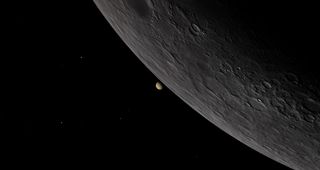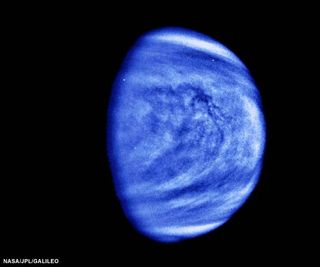Venus Pulls 'Vanishing Act' Behind the Moon on Monday

On Monday (Dec. 7), the planet Venus will do a vanishing act behind the moon, but you'll have to be in the right place on Earth to see it without the sun's interference.
In the course of its monthly journey around Earth, the moon often passes in front of stars, and occasionally planets. On Monday, the moon will pass in front of the brightest of them all, the planet Venus, in what is called a lunar occultation.
This will be visible, weather permitting, all over North America. The only catch is that it occurs in broad daylight. [Watch: A Video Guide to December's Best Night Sky Sights]
I’m often surprised that many people don’t know that the moon is visible in the daytime sky; in fact my son first spotted it when he was about 2 years old. That mainly says that very few people bother to look closely at the sky. On Monday, the moon will be a slender crescent only a few days away from new moon, so may be a bit harder to spot, though if you start observing at dawn you should have no trouble following it up into the blue sky.
Venus is also visible in daylight provided you know exactly where to look. On Monday, its closeness to the moon will help you spot it. The time the occultation will occur depends on your exact location.
For example, in New York City, Venus will disappear behind the moon at 12:43 p.m. EST and reappear at 1:51 p.m. In Chicago the occultation lasts from 11:20 a.m. CST until 12:35 p.m. In Los Angeles, the times are 8:06 and 9:56 a.m. PST. The easiest way to get the exact times for your location is with a planetarium program like Starry Night or SkySafari.

It was observations of occultations by the moon of stars and planets that first told us that the moon has no significant atmosphere. Stars simply wink out and in as they pass behind the moon; planets show no fuzziness as they disappear behind the moon's edge.
Get the Space.com Newsletter
Breaking space news, the latest updates on rocket launches, skywatching events and more!
Starry Night gives you the opportunity to travel to other places in the universe, and view events from a different perspective.

The second image in this guide shows the view of this occultation from the planet Venus at 12:35 p.m. EST (1735 GMT). Instead of an occultation, we see what is called a transit, as one object (the moon) passes in front of another (Earth). The moon is moving from right to left in this view.
The occultation is already over on the U.S. East Coast, to the right of the moon, and has yet to begin on the West Coast, to its left. The surface of the moon looks strange because we are seeing its "far side," the side permanently turned away from Earth. This side has more mountains and craters and fewer open flat plains than the side we usually see.
This article was provided to by Simulation Curriculum, the leader in space science curriculum solutions and the makers of Starry Night and SkySafari. Follow Starry Night on Twitter @StarryNightEdu. Follow us @Spacedotcom, Facebook and Google+. Original article on Space.com.
Join our Space Forums to keep talking space on the latest missions, night sky and more! And if you have a news tip, correction or comment, let us know at: community@space.com.

Geoff Gaherty was Space.com's Night Sky columnist and in partnership with Starry Night software and a dedicated amateur astronomer who sought to share the wonders of the night sky with the world. Based in Canada, Geoff studied mathematics and physics at McGill University and earned a Ph.D. in anthropology from the University of Toronto, all while pursuing a passion for the night sky and serving as an astronomy communicator. He credited a partial solar eclipse observed in 1946 (at age 5) and his 1957 sighting of the Comet Arend-Roland as a teenager for sparking his interest in amateur astronomy. In 2008, Geoff won the Chant Medal from the Royal Astronomical Society of Canada, an award given to a Canadian amateur astronomer in recognition of their lifetime achievements. Sadly, Geoff passed away July 7, 2016 due to complications from a kidney transplant, but his legacy continues at Starry Night.

